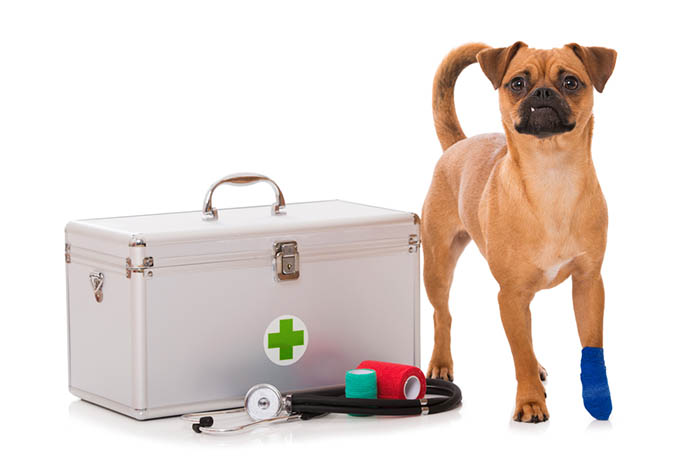A Pet First Aid Kit is important not only in the event of a natural disaster but any time a pet is far away from immediate help; for example when the family takes the pet camping or on vacation out of the area.
Emergencies can strike at any time, whether you’re at home, running errands around town, or traveling. When they do occur, you should always be prepared with a pet first-aid kit, in addition to your human supplies.
When your pet suffers an injury, having the supplies you need on hand can significantly impact your pet’s healing and recovery time. While a pet first aid kit will provide the first line of defense when an injury occurs, a visit to your veterinary should not be ruled out.
This list will help you assemble everything you’ll need in a first Pet First Aid Kit for a pet medical emergencies or health issue.

Table of Contents
Your Pet First Aid Kit Should Contain
- Absorbent gauze pads: essential first-aid item to have around in the event of an injury to either you or your dog

- Adhesive tape: These self-adhering bandages are elastic and breathable and each roll measures five yards long
- Cotton balls or swabs: function in either the application of medicine or the cleaning up of cuts or wounds belonging to your pets
- Fresh 3% hydrogen peroxide to induce vomiting (always check with veterinarian or animal poison control expert before giving to your pet)
- Ice pack
- Disposable gloves: This is what you will wear on your hand to handle the pet. This is safe and it helps to avoid infection.
- Scissors: help cut bandages or gauze to size when needed
- Tweezers: helpful when picking splinters out of your dog’s paw, or ticks out of their fur.
- Antibiotic ointment: non-toxic ointment can be used to treat cuts, sores, rashes, dry skin, and allergies, and is safe for dogs if accidentally ingested
- Syringe: suitable for feeding pets
- Liquid dishwashing detergent (for bathing)
- Towels: can be a useful item to have around in inclement weather or elsewhere.
- Small flashlight: for a durable light that’s good to have on hand for emergencies.
- Muzzle: a muzzle may help to keep them from biting. This breathable, adjustable mesh muzzle will work for any size dog
- Alcohol wipes: this is used to clean the wound
- Styptic powder
- Saline eye solution
- Artificial tear gel
- Thermometer: This is used to check the temperature of the pets
- Phone number, clinic name, address of your veterinarian.
Make sure to check your pack every few months to make sure nothing has expired or needs to be replaced. And of course, keep your Pet First Aid Kit out of the reach of children.

The medicine to take along includes:
Hydrogen peroxide: This can be used in both dogs and cats to induce vomiting. It is not recommended as a wound cleaner as it can destroy “good” bacteria needed for healing.
Aspirin: When you are looking for what to give to your dog to ease the pain and aspirin can be used safely, however, we highly recommend leaving the dosing to your vet. Never give a cat aspirin.
Eyewash: Human eyewash, generally a saline formula, can be used to flush out irritants, but should never be used as a “treatment” for eye/ear infections.
Cortisone cream: This is safe for use on dogs and cats to temporarily relieve rashes and allergic skin reactions.
Antiseptic wipes and sprays.
Antibiotic Cream: This kills bacteria on the skin, and works the same on both dogs and cats. Just make sure you rub it into the skin well, so it’s not removed by licking.
Betadine: This is a wound cleansing solution that is generally safe for use on dogs and cats.
RECOMMENDED ARTICLES
- Portuguese Water Dog: Characteristics, Behaviour And Health
- Panda German Shepherd- Characteristics, Behaviour, And Health
- German Shepherd Wolf Mix- Characteristics, Behaviour, And Health
- 7 Body Characteristics of German Shepherd Chow Mix – Behaviour, Caring & Health
- White German Shepherd – 5 Basic Body Characteristics, Behaviour, Caring And Health
If you like, please share it. Sharing is usually caring




